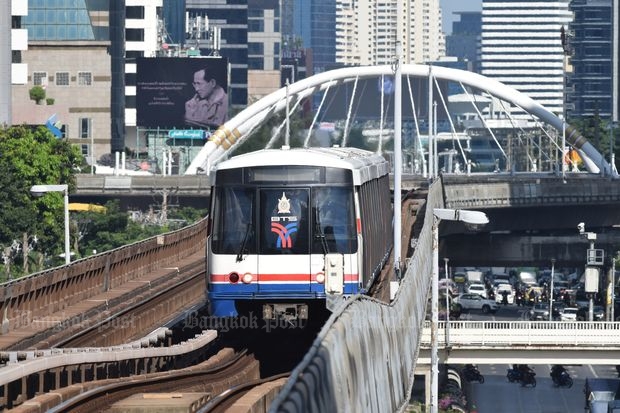Location rules, amenities matter
- Published: 30 Nov 2016 at 11:13 0 comments
- WRITER: Chris Hobden

A BTS skytrain leaves the Surasak station Bangkok's Silom area on Nov 14, 2016. (Photo by Panumas Sanguanwong)
Over the past decade, Bangkok’s mass transit system has acted as of one of the most significant catalysts for development activity, with projects positioned along existing or planned routes benefiting from increased purchaser demand.
While access is fundamental, amenities such as retail space, schools and parks can also define a location, determine its attractiveness and, in turn, act as important decision-making factors for both prospective residents and investors.
Bangkok’s leading schools have played a key role in shaping areas of the city, with affluent families living on the outskirts of the Bangkok Metropolitan Region (BMR), driving sales of residential property in proximity to schools located within central districts, whether to benefit from government catchment quotas or simply to reduce commuting times.
The 1992 relocation of the International School of Bangkok (ISB) to Nonthaburi, in north Bangkok, supported the development of Nichada Thani’s early residential phases.
Although Nichada Thani successfully capitalised on the school’s location to drive residential sales, subsequent attempts at similar schemes have proven unable to replicate comparable levels of sales interest.
While retail schemes more routinely follow, rather than prompt, residential development activity, shopping complexes can heighten the appeal of a locality, as can be seen with west Bangkok’s Bangyai-Ratchaphruek district, complemented by Central Group’s Central Westgate shopping mall. The BTS Purple Line brought access, with the mall serving to enhance the overall appeal of the area.
Proximity to medical care, while a consideration, has not proven to significantly increase sales demand for nearby residential property, although it is noteworthy that hotels and short-stay accommodation, with convenient access to hospitals such as Bumrungrad, Bangkok General and Samitivej, have witnessed rising occupancy rates as a direct result of Thailand’s expanding health tourism sector.
With the number of Bangkok mass transit stations due to exceed 200 by 2020, greater connectivity will pave the way for viable projects in areas currently unsuitable for premium residential development.
Access in itself, while important, will only be one factor in determining a locality’s future prospects, with well-placed amenities able to heighten desirability and create conditions conducive to a virtuous circle of long-term sustainability.
Wider amenities will be the differentiating factor determining the attractiveness between locations benefiting from similar mass transit access and commute times to the Central Business District.
Chris Hobden is senior manager, research and consulting, at CBRE Thailand. Facebook: CBRE.Thailand Twitter: @CBREThailand LinkedIn: CBRE Thailand



0 people commented about the above
Readers are urged not to submit comments that may cause legal dispute including slanderous, vulgar or violent language, incorrectly spelt names, discuss moderation action, quotes with no source or anything deemed critical of the monarchy. More information in our terms of use.
Please use our forum for more candid, lengthy, conversational and open discussion between one another.
Click here to view more comments